 As I mentioned in one of my last tutorials, this tutorial was made for the Canon User Group and I thought I would go ahead and share these tutorials with you as well. I hope you find them helpful and comments are appreciated. Thanks for taking the time to visit my blog.
As I mentioned in one of my last tutorials, this tutorial was made for the Canon User Group and I thought I would go ahead and share these tutorials with you as well. I hope you find them helpful and comments are appreciated. Thanks for taking the time to visit my blog.Tutorial: Manual Mode Made Easy.
I was asked the question the other day by one of our members. The Member was needing some help with "equivalent exposure." I told the member I would work on putting a tutorial together to help explain equivalent exposure.
(As you read this tutorial "Normal Exposure" and or "Proper Exposure" mean the same thing.)
The more I thought about it, I decided that a tutorial on Manual Exposure would probably be the best place to start. I know that we have a lot of members in our group, some more experienced than others. I decided to make this tutorial so that those of you who are not shooting in Manual Mode, may See the benefits of this creative style of shooting, as well as show you that is not as hard to do as some of you may perceive it to be.
OK now here comes the fun Part, If you are reading this tutorial, I will guess that you may well have a desire to shoot in Manual Mode. Get your camera out of its bag and follow along.
On your Shooting Mode Dial, put your camera in Manual Mode.
Look through your view finder, as you are looking through your viewfinder, push your shutter button half way done to power up the camera, just the same as if you were trying to focus your camera.
Note: This tutorial is based on Canon Cameras, Your camera may have a different layout on the numbers, but the basic idea will be the same.
I want to draw your attention to the numbers going across the bottom of your focusing screen, as you are looking through your view finder.
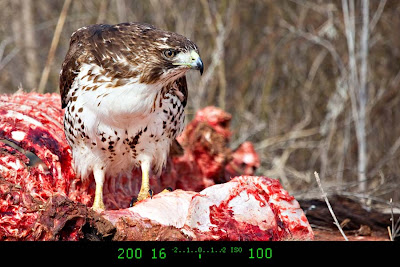 At the bottom of your view finder you should see some numbers in a sequence, something like this image above. (For right now, don't pay as much attentions to the actual numbers as the numbers themselves.)
At the bottom of your view finder you should see some numbers in a sequence, something like this image above. (For right now, don't pay as much attentions to the actual numbers as the numbers themselves.)
The first number you will see is the shutter speed. It tells you what you have your shutter speed set on. (note it is highlighted in red.) The 125 means 1/125th of a sec Shutter Speed. That is the amount of time your shutter will be open allowing light in your camera for your sensor to record the image.

The next set of numbers is your F-Stop. The F-stop is the number highlighted in red. The 16 means the Camera is Set at F 16; I used F 16 since we just did a tutorial on the "Sunny 16 Rule."
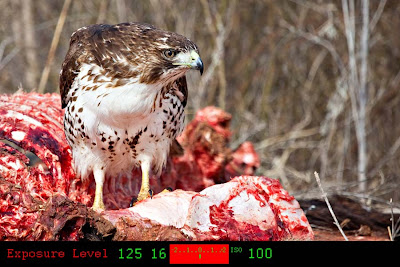
The next set of numbers and dashes is your exposure meter.
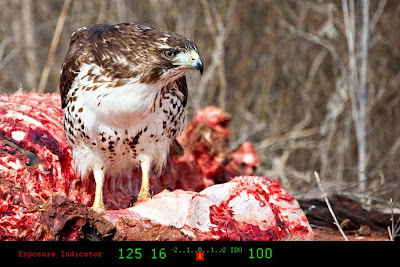
In under the Exposure Level you will find the "Exposure Level Indicator."
**This is the one tool in your bucket that will help you the most when shooting in manual.
It is a tool to assist you in your creativity.
**I want you to keep and Eye on your Exposure Indicator.
I will come back to this tool in a sec after we go across all the numbers on the bottom of your view finder.

The next set of numbers is the ISO. This means that this illustration the camera is set at ISO 100.
Back when we were shooting Film, this was referred to film speed.
**I have no plans to go into what "ISO" "ASA" is for this tutorial, if you would like you can google the terms, and most of you at this point are at the very least familiar with film speed and the pro's and con's to both. (You may see another tutorial from me on Film Speed I guess.?)
**Side Note: I did not make a slide on any other numbers or symbols you may see on the bottom of your camera.
IE the Flash, Burst Rate, etc. I am writing this tutorial on shooting in manual mode and trying to keep it simple.
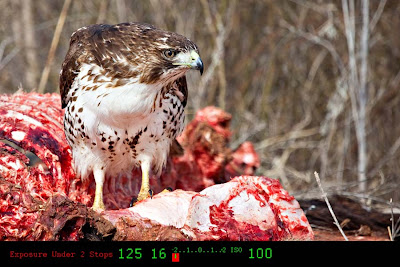
Remember the Exposure Level Indicator I was talking about. This image shows the exposure level to be "2 stops Under Exposed" That means if I clicked the shutter button, This image would be dark to too dark.

I want to draw your attention back to the scale for a second on this Illustration.
If the "Exposure Level Indicator" was blinking in stead of remaining solid, it would indicate that the image is more than 2 stops below Proper Exposure.IE if it is blinking, your camera is trying to tell you, HOLD UP, SOMETHING IS DEFINITELY WRONG HERE, MAKE SOME ADJUSTMENTS, THIS IMAGE IS GOING TO BE SO DARK YOU WONT BE ABLE TO TELL WHAT IT WAS..!!! BLINKING MEANS, FIX ME..
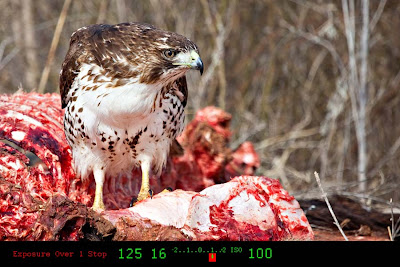 This Illustration shows the "Exposure Level Indicator" as "1 Stop Over Exposed." This means the image will be bright.
This Illustration shows the "Exposure Level Indicator" as "1 Stop Over Exposed." This means the image will be bright.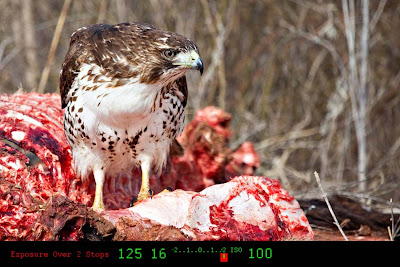 This Illustration shows the "Exposure Level Indicator" to be "2 Stops Over Exposed" The image will be very bright.
This Illustration shows the "Exposure Level Indicator" to be "2 Stops Over Exposed" The image will be very bright.*** The same is true on this side of the scale as well, "if the Exposure Level Indicator is blinking," your camera is yelling at you to make some adjustments, or you will have an image so over exposed you will not be able to tell what it was.

Now that you have a good grasp of how the "Exposure Level Indicator" inside your camera works, and what you are looking at with the exposure scale, you have 3 options for making adjustments to get your "Exposure Level Indicator" to the spot in the scale that will make a Properly Exposed image.
We are going to concentrate on 2 of the 3 for right now.
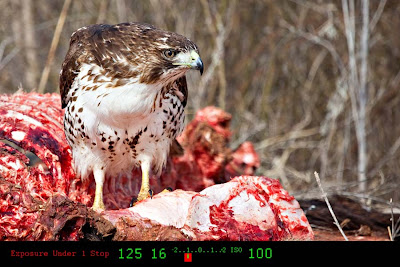
The first one I am going to go over with you is adjusting your shutter speed.
If you were looking through your view finder and your see your Exposure Level Indicator to the left, like it is on this illustration.You will roll the shutter speed dial, (the one right behind your shutter button) to the left 3 clicks.
Why three clicks you might ask?
Your camera came from the factory set on 1/3 stop adjustments.
This tutorial will be talking about adjustments in 1/3 stops as well.
(Side note: You will also notice there are 2 dots between the numbers on the scale, because it is set on 1/3 adjustments.)
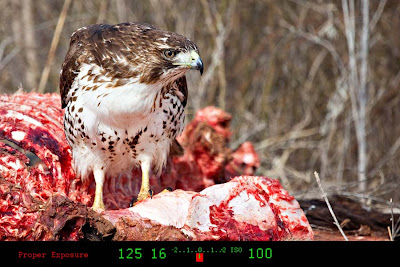 In this Illustration, your Exposure Level Indicator shows the image will be "Properly Exposed" you will not need to make any more adjustments for a Proper Exposure.
In this Illustration, your Exposure Level Indicator shows the image will be "Properly Exposed" you will not need to make any more adjustments for a Proper Exposure. In this illustration your Exposure Level Indicator shows the image to be one stop Over Exposed so you will roll your Shutter Button to the right 3 clicks.
In this illustration your Exposure Level Indicator shows the image to be one stop Over Exposed so you will roll your Shutter Button to the right 3 clicks. In this Illustration your Exposure Level Indicator shows the image will be 2 stops Over Exposed so you will roll your Shutter Button to the right 6 clicks.
In this Illustration your Exposure Level Indicator shows the image will be 2 stops Over Exposed so you will roll your Shutter Button to the right 6 clicks.Now the Second way to make adjustments to your camera for proper exposure is to adjust your F-Stop.
 Same Illustration as previously used is this one with the Exposure Level Indicator showing the image is 1 stop Under exposed. To change your F-Stop you will roll the dial on the back of your camera, to the left 3 clicks.
Same Illustration as previously used is this one with the Exposure Level Indicator showing the image is 1 stop Under exposed. To change your F-Stop you will roll the dial on the back of your camera, to the left 3 clicks. Same Illustration as previously used with the Exposure Level Indicator showing the image is 1 stop Over Exposed, roll the F-Stop adjustment wheel to the right 3 clicks to bring it back to Proper Exposure.
Same Illustration as previously used with the Exposure Level Indicator showing the image is 1 stop Over Exposed, roll the F-Stop adjustment wheel to the right 3 clicks to bring it back to Proper Exposure.***In this tutorial, I am simply trying to get you to understand How your meter in your camera works and how to make adjustments in manual mode. The Following tutorial on Equivalent Exposure will explain in more detail why you may want to change either the Shutter Speed or the F-Stop Depending on the image you are going to artistically create.
***HUGE NOTE: When I was making this tutorial I started to show the image in the view finder as under exposed, properly exposed, over exposed as it would look if you took the shot as the meter was indicating. But the simply fact is, when you are looking through your view finder, your camera is not going to show you by the image you can see if it is properly exposed or not, it just lets you see the image as it is, and the Exposure Level Indicator shows you if it is under exposed, properly exposed, or over exposed, just like the illustrations I have added. Maybe sometime before I am long gone the camera makers will have some sort of fancy preview button that will show you what the image will look like, as you are looking through the view finder, but for now they don't.
ANOTHER NOTE: I a fully aware, that the numbers listed on the bottom of the illustrations are all the same. I am not trying to confuse anyone about the numbers at this point. I am simply drawing your attention to the Exposure Level Indicator and what to look for when shooting in manual mode. At this point we are just breaking ground in shooting in Manual Mode and Not trying to muddy the waters with the pro's and Con's of the actual numbers and what they mean.
I debated this last illustration for a while, as to add it to the tutorial or not. After a long debate I decided to add it so you will have the information if you want it.
Have you ever heard a photographer say "shoot to the right" or I am going to "Shoot this to the Right"
Here is what they are talking about.
Additional Tip: Shooting to the Right.
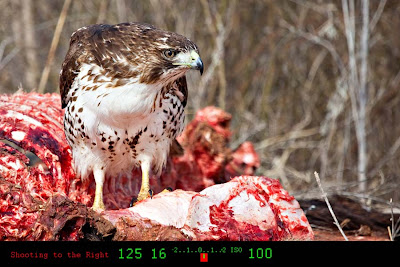
Notice the Exposure Level Indicator is One dot to the right of "Properly Exposed." You might ask your self why you would want to shoot to the right. Well it comes from a combination of Canon equipment and Photoshop editing. If you have done very much editing in photoshop, you know that if you have a dark image and you want to make it brighter you are going to "add" a lot of noise to the image. If you are trying to make it a lot Brighter because it was too under exposed, then you will be "adding" a ton of noise to the image.
Why shoot to the right.? When you are in Photoshop, you can bring the brightness down with out adding noise to your image. So in short, you can take a slightly bright image, bring it back to normal and not be adding any noise to your image.
Again, this tutorial is for Shooting in manual, I will not go into all the pro's and con's of "shooting to the right" but you at least have some more knowledge and you can decide if you want to try it or not.
Lastly The 3rd Adjustment you can make to your "Marriage" of the "Proper Exposure" is the ISO or Film Speed. I am going to just give you some really basic information on the Film Speed and How and Why you may want to use it for this tutorial on Shooting in Manual Mode.
As a general rule, your Film Speed (ISO) has been given a number that tells how fast it can record light. The less light your scene has the Higher the Number your Film Speed will need to be. Here is some basic ISO guidelines.
OUTSIDE Bright Sun ISO 100
OUTSIDE Shade ISO 200
INDOOR Bright Lights ISO 400
INDOOR Med Lights ISO 640-800
INDOOR Low Light ISO 800+
Again, to keep from muddying the waters, these are some general guidelines for a starting point on setting your ISO. We may well need a tutorial on ISO and I may do that in the future, but for now, this is a close point to start and why you may need to change the ISO on your camera when shooting in Manual Mode.
I hope that this tutorial has been helpful as well as easy to understand. I also do not have a secretary who is reviewing my work so if I have made a typo or something you can send me a note and I will correct it. Thanks for any feedback you may have and I hope this tutorial will be of some use for some of you out there.
Dale
Dale Frazier Photography.


No comments:
Post a Comment